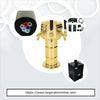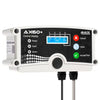How to size the beer lines of your long-draw beer system?
Sizing the trunk line is a fairly complicated question, as it depends on pretty much all the other parts of a long-draw system. However, there are some simplifications that can be made, and at the end of the day this is not rocket science. The goal is just to have the system in balance so that the beer flows at a good rate and doesn't foam too much. So, how do we achieve that?
Please note that we will focus on selecting the right product line size (finding the right interior diameter of the beer line). Selecting the amount of product lines is easier: it's just a matter of how many beers you want on tap. Do note that this affects the number of glycol lines (trunk lines with 10 or more product lines have 2 glycol loops) and that in turn affects the glycol chiller sizing. You can read more on that in the trunk line collection page instructions.
Beer line diameter
Generally, the longer the total run, the larger the diameter of the product lines needs to be. We have three sizes (from smallest to largest):
-
1/4" (64 millimeters) Inside Diameter (I.D)
-
5/16" (79 mm) I.D
-
3/8" (95 mm) I.D.
The smaller the diameter of the product line, the more restriction the line has (more pressure is needed to push the beer through the line). This is important to note when doing the calculations for the total balancing of the system.
Balancing the system: keg pressures
Beers need to have a right amount of CO2 pressure in the keg to maintain the right level of carbonation. This is measured by CO2 volume: for a keg of beer, how many uncompressed keg volumes of CO2 are compressed into the beer? This amount varies by each beer type, being usually between 2.2 and 2.8 volumes of CO (but can be anything from 1.2 to 4.2 for specialty beers). The right amount is specified by the breweries per each beer. The gas pressure questions can get really complicated, so for the purpose of just selecting the right trunk line, we are going to assume some pressure numbers in the later examples.
Balancing the system: flow rates
In order for the beer flow at the right rate (about 1 gallon per minute, 8 seconds to fill a pint) and without foaming too much, the system needs to have the right amount of restriction: the gas pressure applied to the beer needs to equal the total amount of restriction in the system. Different beer types need different amounts of CO2, and with more CO2, the gas pressure grows. If there is too much pressure, and too little restriction to balance out that pressure, the beer comes out of the foamy. If there is too little pressure vs. restriction, the beer may not flow fast enough.
While the keg pressures can be altered a little bit to change the flow rates, this will quickly cause other issues. That's why in system design the keg pressures should be assumed to be constant. The systemic resistance needs to be matched to the keg pressure, not the other way around.
Systemic resistance factors: static and dynamic resistance
There are two types of resistance: static and dynamic. Static resistance basically mean gravity: if the dispensing station is lower than the kegs, then the static resistance is negative. If the serving station is higher than the kegs, then the static resistance increases. If the line goes up and down the same amount, the ups and downs equal themselves out. Each foot of increased height will add about 0.5 pounds of resistance to the system.
In long-draw system, the total resistance mainly comes from Dynamic resistance. It means the internal resistance from the beer system hardware, mainly the beer lines. The total beer line usually consists of 3 parts:
-
The jumper inside the walk-in-cooler (usually about 6 feet of vinyl tubing)
-
The trunk line, running from the walk-in-cooler to the tower
-
The choker, short small diameter line, usually 3/16" (48mm) I.D vinyl tube
The product lines in towers are usually 3/16" I.D vinyl, acting as the choker line. Couplers and other parts of the system usually have resistance values of practically zero.
The choker is the "final piece of the puzzle" that is used to fine-tune the total resistance to the optimal number. As the 3/16" vinyl line has such high resistance, it is easy to increase or decrease the total resistance by varying the length of the choker. Most of the UBC towers have 5-6 feet of 3/16" I.D vinyl line as the product line. The right amount of resistance can be had by first selecting a trunk line with amount of resistance that's close to target amount, and then cutting the tower product line to right length.
When you add up the static (gravity) and dynamic (beer lines and other hardware) resistance numbers, you get the total systemic resistance amount. This is what needs to match the applied keg pressure.
Mixed gas systems and beer pumps
There is a limit to the total run lengths that can work with CO2 alone. Long runs require more gas pressure to move the beer over the distance, and just adding CO2 pressure leads to over carbonation of the beer. There are two solutions: either the gas mix for the beer needs to be changed (by adding nitrogen), or with really long runs, the beer can be pumped by mechanical force (using a beer pump). These solutions add more complexity to the system, and those details are a topic for another blog post. For now we are just going to use some ready-calculated numbers in the part 2 of this blog post: the calculation examples.










